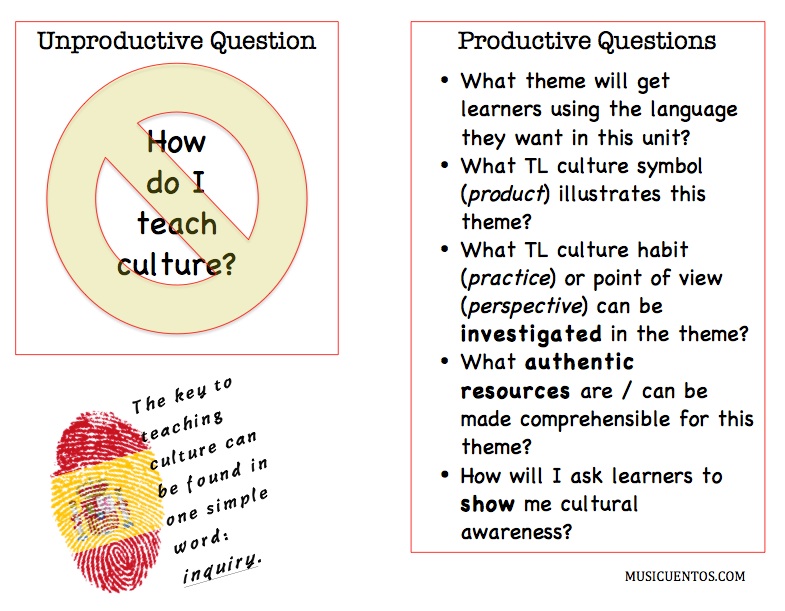What is the point of teaching culture, anyway? Is it to get kids to realize that people are different? (They already do.) Is it to get them to try a new food? (Lengua, eww, gross. Does that have peanuts in it?)
No, cultural awareness is more about perspective-taking. According to the research, children who show empathy will be more successful in life. And what is empathy? It’s “the ability to understand and share the feelings of another.” It’s perspective-taking.
As I hear teachers ask this question a lot,
How can we teach culture?
I think I always felt we were asking the wrong question, but not until my recent interest in 1) empathy research and 2) design-based learning did I identify why I felt this way. Asking how I can teach culture is asking how I can transfer some knowledge I supposedly have to a learner, and that’s just not it. So as I worked my way through how I felt about teaching culture, I identified the one word I believe is the answer to “teaching” cultural awareness in the classroom.
INQUIRY
Inquiry-based learning models are following the research that says that children who investigate the big questions are more successful in just about every way. So let’s start asking questions. Better yet, let’s get learners asking questions, present the sources of some answers, and let them have at it.
Not: “Mexicans eat different foods than I do.”
But: “Why do Mexican families eat parts of the animal that my mom throws in the trash? Do they think it’s delicious? How do they cook it? I wonder if I’d like it if I tried it the way they make it?”
Not: “Nicaragua grows a lot of coffee.”
But: “Why don’t Nicaraguans drink the coffee they grow? What are the expenses involved in brewing and drinking coffee? How much do I spend on coffee, and how much of that ends up with the coffee farmer?”
Not: “Avocados are an important export in Mexico.”
But: “Why is the drug trade affecting avocado production in Mexico? Who may have picked the avocado in my kitchen, and what is his life like? What would I do in his shoes?”
You can see how these questions reach the beliefs in the culture – why do the Indians mistrust third parties who want to market their cultural goods?
I can sense your question: how do we approach these issues while staying in the TL? Jury’s still out on that one, but I do have a few preliminary answers. One is that it’s a good use of the English time you may be allowing in your classroom (10% or less on ACTFL’s recommendations). Another is to put it in an at-home portion of your class (a flipped model). One more – focus on authentic resources at all levels, and make them comprehensible for novices. Whenever I meet a teacher who is struggling to teach culture, some probing questions reveal that the class is heavily focused on language explanations and use and there’s little interpretive work with authentic resources. The people themselves will expose students to culture if we let them.
Ready for some more questions? From a curriculum design perspective, here are some of what I think are better questions to ask when contemplating cultural content in the classroom.

How to answer these questions is a great topic to address at the Camp Musicuentos curriculum design workshop. Louisville’s on a wait list right now, but there are several spots open if you can get to Rhode Island in July. If you’d like this information as a PDF to print and post for your department, download it here.
3 Comments
Comments are closed.





[…] The one-word key to teaching culture. […]
[…] So in addition to the possibility of homework self-selection, I think I’ll also let students pick through these the first week or so of classes to practice this sort of analysis and promote questioning and cultural inquiry. […]
[…] To celebrate, I would like to share not only my photos, which I have collected in this gallery for your viewing/selection pleasure, but also some ideas for how they might be used to further cultural inquiry. […]